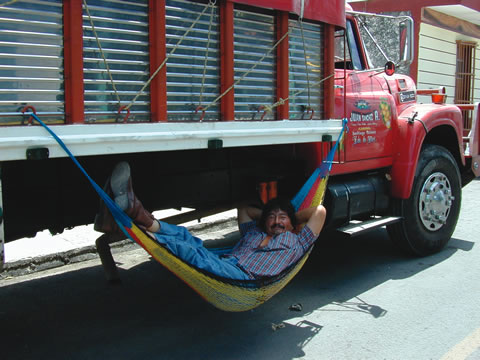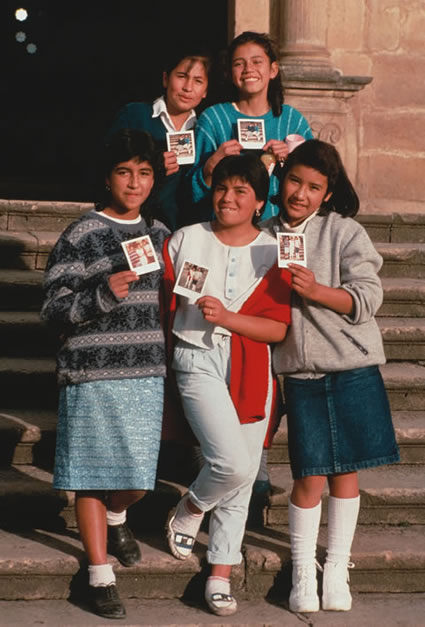Travel Portraits
Master the Art of Taking People Pictures in a Culturally Sensitive Way
Article and photos By Karen Schulman

|
|
The author offered a gift to this woman before photographing her in front of a church in Atotonilco, Mexico.
|
How do experienced travel photographers make excellent travel portraits? Are there tricks to learn? The answers are below:
Do Your Homework
Learn about the place you are visiting ahead of time, not just before your plane lands. Are you visiting an area where the indigenous people may be reluctant to be photographed because of their beliefs? Will you need
formal permission to even use a camera in the area? Are there market days or festivals during your visit? These can be wonderful opportunities to photograph ordinary people in their everyday lives.
Know Your Comfort Zone
For many people, communication isn't one of their greatest strengths. When they travel outside of their comfort zone they are confronted with habits and situations that can be confusing and frustrating. The key to
transcending these feelings is developing patience, curiosity, and open-mindedness.
Be Ready
Know your photo equipment and have your technical tools ready. You may choose to pre-set the camera's controls or shoot in a programmed mode so that you will be able to concentrate on your subject. Think about the
types of images you want to make. Wider angle lenses (20-35mm) show more of the environment along with your subject. Portrait lenses (85-150mm) allow you to zoom in on a person's face or the details of the scene. Usually both types of
pictures are important to tell your "story." Decide if you will need to use a little "fill" flash if the light is very contrasty or the subject is in heavy shade.

|
|
While walking around San Miguel, Cozumel, Mexico, the author happened upon this man taking an afternoon siesta; he was pleased to be the subject of a photo.
|
Establish Trust
Establishing a relationship, however brief, is key to good portrait photography. Instead of trying to "capture" images of everyone you see, spend a little more time with fewer people. If you know a little
of the local language, that's helpful. If not, a smile and body language are understood everywhere. Be respectful and sincere. If you come across a family selling goods in a marketplace, you can easily stop and talk with them about what
they are selling. You may even choose to make a small purchase. Many of my favorite photographs come about from these brief encounters.
Direct the Photograph
Whether or not you choose to direct the people in your photograph is ultimately up to you. Some photographers feel that it takes away from the spontaneity of the moment. Others feel that if you ask people to move a
little this way or that, sit down, stand up, continue working on their weaving, etc. there will be a greater chance for a successful photograph. This is where you can use your intuition and experience. When in doubt, do a little of both
and decide which you prefer while you are editing.

|
|
The author used a Polaroid camera to photograph these Colombian girls, and then she
gave them each a photo.
|
Finding the Background First
If photographing the landscape is more appealing to you than close-up people photography, it often works well to find an appealing environment, a colorful storefront, a scene that can stand on its own, but one that
just improves with the addition of a person passing through. Set up and wait for a subject to enter your viewfinder. Hang out for a while and see how many different images you can make from this one background. This also helps to tell
your photo story as it gives information about his or her lifestyle, culture, and surroundings.
To Tip or Not to Tip
This is a tough subject for sure. In more remote locations you may have the dilemma of whether to pay the subject or offer a Polaroid. It's hard not to want to offer something to the children, so carrying gum or candy
in your pocket is always an option. Travelers are often perceived as being "rich," and certainly, compared to the wages in some of the lesser-developed countries, this is true. It's easy to see how this perception exists when
we are loaded down with multiple camera bodies, long lenses, strobes, and other "luxuries." The sheer numbers of tourists visiting remote areas of the world is part of the reason for this. Here again, some research about the
area can be helpful. If you are traveling with an organized tour to a small village, the tour company may pay a fee for the privilege of photographing the locals.
Ask Permission and Express Gratitude
Usually people don't mind being the subject of your photo if you are unobtrusive and act quickly; but how can you be unobtrusive with cameras dangling off of your shoulders and that large pack on your back? Carrying
minimal gear while walking around the streets of Cozumel, Mexico, I find it easy to smile and say, "Saco foto?" (May I take your photo?) After the initial photo or two, usually with the person looking right at me, they go back
to their activities and I hang around for a more candid moment. Over the years, I have found that asking for permission feels better to me than sneaking the photo from across the street with a long lens. Of course, there may be times for
both.
Let your subject know how much you appreciate them taking the time to allow you to enter into their lives and make your photographs. Many people love the attention of being photographed and that in itself will be enough.
Being natural, being yourself, and expressing your gratitude will go a long way in your pursuit of making memorable people pictures.
Throughout my travels, my camera is my tool — for knowledge, personal growth, and exploration. By combining sensitivity to having people as my subjects and respecting their individual and cultural differences,
I am able to look back at my travel portraits and know that each special moment, each image, has become an important part of who I am today.
If you have previously been fearful about making people pictures while traveling, practice at home first with your family and friends or visitors to your hometown. Then take these suggestions on the road and let me
know how it goes.
|
